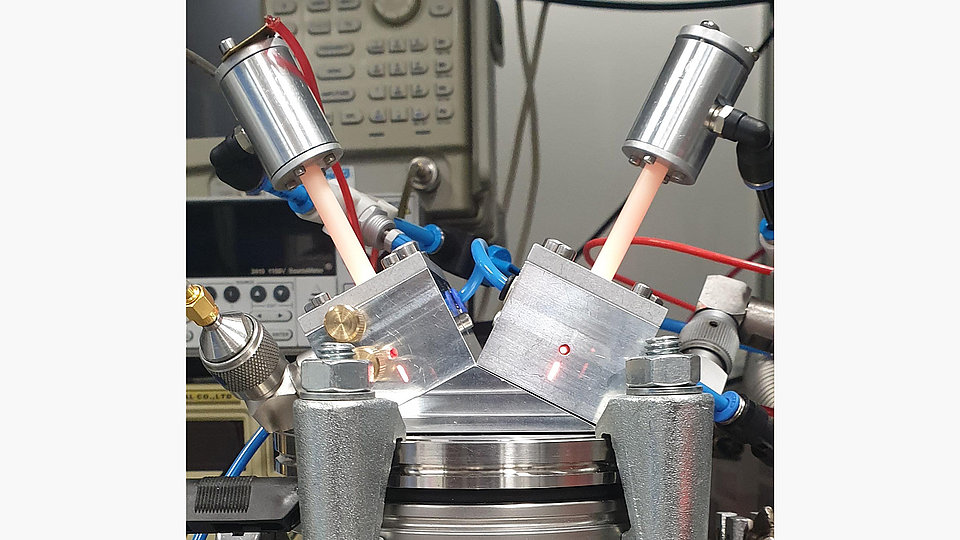Efficient coating – dual ICP plasma source for silicon dioxide deposition
An earlier project was dedicated to the study of inductively coupled plasma (ICP) sources excited at microwave frequencies. It aimed at identifiying the conditions in which the excitation is indeed in an inductive and not in a capacitive mode. Now, a new project started that will go into further detail, studying different gases at higher pressure and at higher powers.
As a basis, we use the new generation of sources, designed and technically realized at FBH. These sources allow us to tune the resonance frequency and the impedance transformation. Thus, one can operate them with different gases and pressures with an almost ideal transfer of energy. The main focus now lies in the independent excitation of oxygen and hexamethyldisiloxane (HMDSO) plasma. The standard industrial process uses HMDSO plasma to coat plastic bottles with SiO2. The thin glass film protects liquids from unwanted contaminants originating from the plastic material. In order to carry out this coating, we utilize a 1 kW magnetron and a pulsed excitation regime in the industrial process.
In our new procedure we use two microwave generators with powers of 20 – 40 W that drive two ICP sources. Because the two gas flows and excitation powers can be independently controlled, we expect the deposition to be energetically more efficient. Fig. 1 presents a special design, intended to test and optimize the deposition conditions at a small scale. Dual or quadruple ICP sources, that were developed in a different project, will be used in large arrays in order to cover bigger surfaces. Moreover, the microwave-driven ICP sources work at high pressure, up to atmospheric pressure. In this way, the vacuum chamber can be eliminated, making the process significantly cheaper. The microwave excitation of plasma allows to generate relatively low temperature ions or radicals even at atmospheric pressure. This makes it easy to extend the deposition even to temperature-sensitive surfaces.
This research is supported by the DFG “Characterization and explorative application of a novel miniature microwave ICP” project PO 1018/5-3, No. 389090373. The project runs from December 2021 until April 2025.
Publications
M. Klute, E. Kemaneci, H.-E. Porteanu, I. Stefanović, W. Heinrich, P. Awakowicz, and R. P. Brinkmann, ”Modelling of a miniature microwave driven nitrogen plasma jet and comparison to measurements“, Plasma Sources Sci. Technol. 30, 065014 (2021)
M. Klute, H.-E. Porteanu, I. Stefanović, W. Heinrich, P. Awakowicz and R. P. Brinkmann, ”Theoretical investigation of a miniature microwave driven plasma jet“, Plasma Sources Sci. Technol. 29, 065018 (2020)
H.E. Porteanu, I. Stefanović, N. Bibinov, M. Klute, P. Awakowicz, R.P. Brinkmann, W. Heinrich, ”Correlated Mode Analysis of a microwave driven ICP source“, Plasma Sources Sci. Technol. 28, 035013 (2019)
I. Stefanovic, N. Bibinov, H.E. Porteanu, M. Klute, R.P. Brinkmann, P. Awakowicz, ”Optical characterization of a novel miniature microwave ICP plasma source in nitrogen flow“, Plasma Sources Sci. Technol. 27, 12LT01 (2018)
